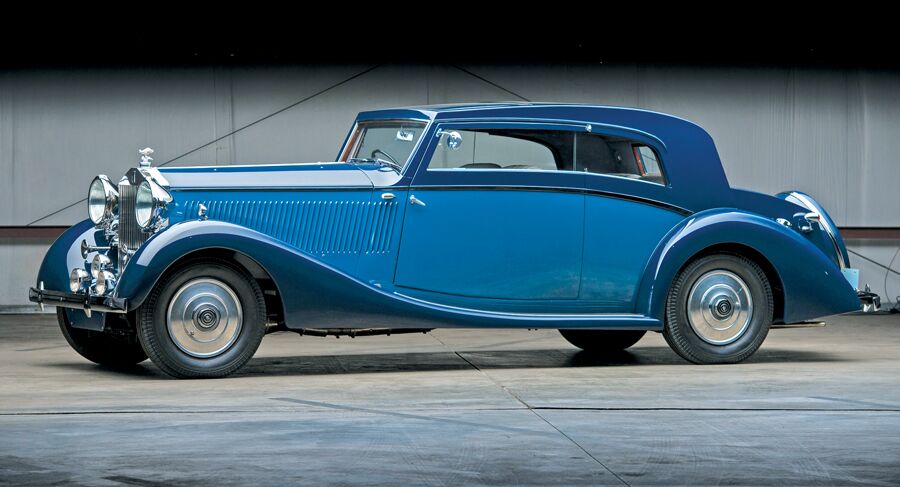SCM Analysis
Detailing
| Vehicle: | 1937 Rolls-Royce Phantom III pillarless 2-dr sedan |
| Years Produced: | 1936–39 |
| Number Produced: | 710 to 719, depending on source |
| Original List Price: | £1,900 (about $100,000 in current U.S. money) |
| SCM Valuation: | $593,000 (this car, which has one-off coachwork) |
| Tune Up Cost: | $3,500 |
| Chassis Number Location: | Inner wing and bulkhead |
| Club Info: | Rolls-Royce Owners Club |
| Website: | http://www.rroc.org |
| Alternatives: | 1939 Rolls-Royce Vutotal Cabriolet by Labourdette, 1936 Rolls-Royce Phantom III Sport Coupe by Barker, 1937 Rolls-Royce Phantom III Sedanca de Ville by Freestone and Webb |
| Investment Grade: | B |
This car, Lot 261, sold for $593,500, including buyer’s premium, at RM Sotheby’s Arizona Sale at the Arizona Biltmore on January 19, 2018.
The Rolls-Royce Phantom III was referred to by its maker as “the most luxurious road vehicle ever produced.” It was born out of necessity, as the outmoded 6-cylinder Phantom II faced stiff competition from smooth-running V12s and even V16s.
While Rolls-Rolls did not have the engineering resources that were available at General Motors or even Packard, they were experienced with V12 technology due to their aeronautical designs.
Work on the V12 began in 1932, but Henry Royce, who was described as a “merciless critic of design,” died in April of 1933.
Thereafter the engineering was not as precise.
Power and complications
There was little thought regarding the cost of production, and the engine design precluded practical overhaul. It seemed that the Rolls-Royce engineers operated with the premise that if one part will do, then several are better.
For example, the lubrication system metered oil at three different pressures and had a system of copper tubes that measured the pressures at hundreds of locations.
The spring leaves were individually machined and drilled with holes, which provided lubrication. Hydraulic jacks were built in, and a tire could be changed or winter chains installed without having the passengers leave the car. Oil leaks were just one of the obvious concerns.
The Phantom III was presented at the 1935 London Olympian Motor Show, and deliveries began the following year. The chassis was priced at £1,900, well over $100,000 in today’s dollars.
With independent front suspensions — derived from General Motors — quick steering and powered by a massive 7.32-liter V12, these cars were a treat to drive. Rolls-Royce, however, recommended a maximum sustained speed of 75 mph to 80 mph to avoid mechanical issues.
Not usually a fancy chassis
The Phantom III chassis did not lend itself to distinctive coachwork. A couple of factors were at play; with the engine and steering wheel moved forward, the proportions were not as graceful as the Phantom II and the typical buyer of the Phantom III was older. They were, for the most part, acquiring a chauffeur-driven vehicle, so the cars were more vertical, sedate limousines.
One of the exceptions was the Phantom III Pillarless Saloon with one-off coachwork by the little-known Brussels coachbuilder Vesters et Neirinck.
Where most Phantom III bodies were rather stodgy, this design was sporty, with flowing, elegant lines that were, as noted, reminiscent of the designs of French coachbuilder Letourneur et Marchand.
An interesting life
Our subject car was first exhibited by Vesters et Neirinck at the Brussels Motor Show in 1938. Shortly thereafter, it was delivered to its first owner.
At this point the fascinating tale of its ownership begins. It was rumored that the king of Belgium and British Field Marshal Sir Bernard Montgomery owned it during the war. If this could be documented, it would certainly add to the allure.
As World War II ended, the British Army of the Rhine acquired the car.
The car was taken to the United States, and after numerous owners, it became the property of G. Gordon Liddy of questionable Watergate fame. Liddy licensed the Phantom III with an Arizona vanity plate “H2O GATE” to, as he stated, “say ‘Hi’ to the liberals.”
The car was restored between 1992 and 1995 and went on to win its class at the Pebble Beach Concours d’Elegance and at the Rolls-Royce Owners Club National Meet. It was last seen in 2005 at the annual Blackhawk exposition at Pebble Beach, where it was offered for an undetermined amount.
Many Phantom III cars still live
There were 710 Phantom IIIs produced between 1936 and 1939, with most going to the nobility. It is thought that slightly less than half have survived. Considering the difficulty of maintaining the Phantom III, it is a tribute to the most lavish and innovative Rolls-Royce that so many are still with us.
Commenting on the value of a one-off car is not an exact science.
The SCM Platinum Auction Database lists several Phantom III transactions, with more-common limousines selling in the $200,000 range.
In 2012, RM Sotheby’s sold an exciting Aero Coupe, with a rebodied design, for $473,000. This Phantom III saloon, however, goes to the head of the class. Its exciting design, a well-maintained older restoration and an interesting history put this car in the sweet spot for this model. Well sold and well bought. ♦
(Introductory description courtesy of RM Sotheby’s.)
